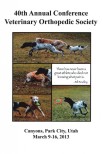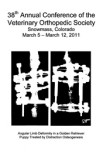Objective: To assess whether the location of a bi-oblique dynamic proximal ulna osteotomy (BODPUO) affects the change in angle of proximal ulna tilt from the time of surgery to 6-8 weeks postoperatively.
Study design: A retrospective, single cohort study.
Sample population: A total of 45 elbows from 41 dogs were enrolled in the study.
Methods: Immediate postoperative and 6-8 week postoperative radiographs were reviewed to determine the location of the BODPUO in relation to the total ulna length and the change in proximal ulna angle achieved postoperatively. The median duration of follow-up (final postoperative radiographs) was 6 weeks with a minimum and maximum of 4 and 10 weeks, respectively. Regression models were used to generate prediction intervals to describe the change in angle that would be expected following a BODPUO in individual future cases, based on the location of the ulna osteotomy.
Results: A total of 41 elbows (one per patient) were used in the statistical analyses. A more proximal BODPUO resulted in a larger postoperative increase in the proximal ulna angle. The most proximal osteotomy, at 26% of the total ulna length, achieved the greatest change in proximal ulna tilt of 18°. For a particular location of a BODPUO in future cases, the change in angle achieved may depend in part on the initial proximal ulna angle (IPUA).
Conclusion: There was a strong relationship between the location of a BODPUO and the change in angle of the proximal ulna postoperatively, with more proximal ulna osteotomies achieving the largest change in proximal ulna tilt.
Clinical significance: These findings provide objective data on the change in proximal ulna tilt for varying locations of a BODPUO.









